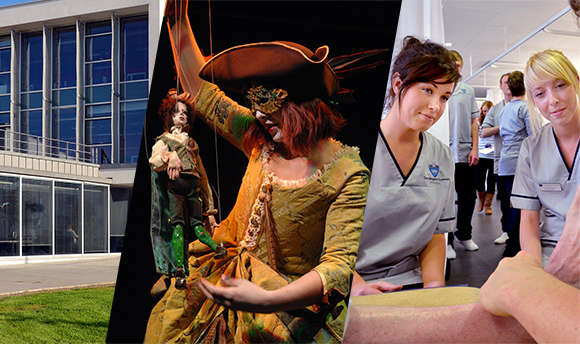Performance Enhancement Review Policy
Document Control
| Date Approved by SLT | December 2016 |
|---|---|
|
Date of EQIA |
TBC |
| Document Owner | Human Resources |
| Last modified | September 2021 |
| Next review date | September 2022 |
1.0 - Introduction
QMU adopts a holistic approach to performance management. Performance enhancement is considered a dynamic activity led by employees in interaction with supportive managers, and as such an 'entitlement approach' is taken.
Every employee is expected to seek to enhance the quality of their work and are entitled to access the appropriate processes and support which they need to achieve this up to the level outlined in this policy. At the same time, QMU has an expectation that employees will contribute to, and participate in, the strategic objectives of the University which may, from time to time, vary. The PER is offered as a mechanism to facilitate both these objectives, by providing a consistent process across the University which all employees are entitled to access through their line manager, and which may be adapted as appropriate to the needs of the employee in pursuit of enhancing their performance.
Whilst some employee may choose not to access their entitlement to a PER, all employees will be given a set of objectives which are in accordance with the role they perform and their job description.
2.0 PER Principles
1. Objective Setting:
All employees will have objectives compatible with the university’s delivery plan and overall strategy, their responsibilities of scholarship to their discipline or profession, and the collective development of staff teams. Objectives may be short, medium, long term or ongoing. Employees may also set professional development objectives.
2. Employee Led Process:
All employees are professionals and, with support of the university, will seek to enhance their own performance. On this basis the performance enhancement process will be genuinely employee led. Individual staff objectives will be based on collegially developed team objectives wherever possible.
3. Enabling Career Development:
All employees will have access to professional development opportunities to further support the enhancement of their performance and career progression. (This will be proportionate to the nature and demands of each member of staff’s role and stage of career).
3.0 Aims and Objectives
The overall aim of performance management is to develop a shared understanding about what is to be achieved by the University and how the employee contributes to its overall direction. This shared understanding supports the approach that is taken toward areas such as leadership and staff development. The aim is to ensure such approaches locally align to support the delivery plan and QMU’s strategy.
Performance management, including Performance Enhancement Review, is a process that contributes to the effective management of individuals and their School/Departments. Overall this helps shape the performance of the University – see below.
INSERT PICTURE
The focus of performance management at QMU is about ensuring the appropriate structures, support and opportunities are in place and that they combine to achieve the University strategy.
As part of the overall enhancement of University performance, the specific aims of PER are to:
- Discuss the Operational Plan, linking to the individual’s role and activities and clarifying the individual’s contribution to the Operational Plan
- Create a shared understanding of the role
- Help to prioritise workload and objectives effectively
- Provide ongoing coaching on performance and agree the level of performance expected
- Provide the opportunity to discuss career aspirations and development plans
In many areas, the organisation and allocation of work and accountability for enhancing performance is best performed collectively, in which case a team-based approach to the PER would be encouraged. It is likely that effective teamwork will lead to clarity of role and enhanced performance of strategic and operational objectives, both individually and collectively. This approach, however, does not negate the entitlement of individual employees for access to PER, and the Line Manager should ensure that, following team processes, a PER meeting with each team member is available. This aims to ensure the individual has the same opportunity as all others across the University, in terms of the aims of the PER meeting.
4.0 Scope of the Policy
This policy applies to all staff who are employed by Queen Margaret University in a substantive post. A substantive post is a post which is defined in the University core staffing structure.
5.0 Data Protection
All information gathered on individuals as part of this policy will be processed in accordance with the provisions of the General Data Protection Regulations (GDPR).
6.0 Induction, Learning and Development
HR offer training, advice, support, guidance and coaching for all staff involved in the implementation and application of this policy. The aim of this development is to provide awareness of University policy and best practice, the legislative framework, including equal opportunities, and to enhance skills in managing and participating in the implementation and application of this policy.
The ‘YourInduction Plan’ provides the staff members and their Line Manager with a plan to develop their skills and understanding of their role. Part of the Your Induction Plan is to set PER objectives.
7.0 Equality, Diversity and Inclusion
The University is committed to equality of opportunity for all staff. It is the responsibility of all employees to promote equality, diversity and inclusion in the application of the PER, ensuring that there is no discrimination on the grounds of the protected equality characteristics1.
8.0 Responsibility for this Policy
Human Resources is responsible for monitoring the effectiveness of this policy and will review this policy as required. Any changes to this policy and supporting procedures will be made in consultation with appropriate bodies. QMU reserves the right to update HR Policies and procedures in line with new or updated employment legislation.
9.0 PER and the University’s Planning Process
The Performance Enhancement Review is a fundamental element of the University’s planning process. The PER process provides the interface between the Strategic Plan and all staff. It aligns the objectives developed in the University’s Strategic Plan and Operational Plans with individual objectives of all staff and their professional development. This is displayed below:
INSERT DIAGRAM
10.0 Objective Setting and Performance Levels
Objective Setting
Individual objectives can be expressed as:
· targets to be achieved, or,
· activities to be completed by a specified date.
Objectives should be directly work-related (referring to job results to be achieved). It should be clearly defined and agreed and relate to all the various aspects of the job that contribute to achieving the role purpose.
Performance Level
Performance levels sit alongside objectives. It is recognised that individuals may perform at different levels. For example new members of staff will be likely to contribute at a different level to that of a more experienced member of staff. The skilled Line Manager recognises this and applies this understanding to create an effective PER: tailoring conversations and agreeing developmental objectives/career plans to the position, abilities and aspirations of the individual.
For an objective to be managed effectively, individuals and Line Managers must know and agree the basis on which performance will be measured.
11.0 School/Department Learning and Development Plan
The University provides a local learning and development budget held at Dean/Director level. The Dean/Director is responsible for ensuring the allocation of this budget to staff development and also for delegating this responsibility to Head/Manager, when appropriate. The University also holds a central development budget which is used to provide training and development for all staff. The PER process is used to identify training needs, from the development needs identified HR produce the DEVELOP calendar on an annual basis. All staff can access the DEVELOP calendar and book themselves onto appropriate training via Employee Self Service.
12.0 Performance Enhancement Review: Roles and Responsibilities
Deans/Directors are responsible for the effective implementation of PER across their Schools/Departments. It is likely and expected that the PER process is cascaded through the School/Department in line with Operational Planning requirements. PER progress will be tracked via YourContribution, managers and HR can access reports on progress via the system at any time.
Individual members of staff are responsible for positively engaging in the process, preparing for review meetings, contributing during the meetings and drafting the PER.
Human Resources are responsible for supporting managers in the implementation of the PER and for the on-going development of the policy and the YourContribution system. HR will also provide guidance, coaching and development solutions for both staff and Line Managers.
13.0 Performance Enhancement Review and Unsatisfactory Performance
The PER process is not designed to address ongoing unsatisfactory performance. Unsatisfactory performance is defined as a level of performance that does not meet the required standard expected of the employee. Unsatisfactory performance needs to be addressed as soon as it is identified and The Management of Performance Policy provides further guidance.
14.0 PER Agreement
The Line Manager and the employee should discuss and agree the best approach to performance enhancement. In some cases employees’ performance enhancement and professional development is best achieved through mentoring, networking, collegiate discussion or personal reflection. At other times a more or less frequent PER is more appropriate. To this end, the employees should indicate to the Line Manager the level of support most appropriate to their own professional development and performance enhancement and should agree to abide by this level of support. For example, a PER agreement might include:
• Regular PER meetings plus access to manager for additional support;
• Annual PERs;
• Mentorship from other individuals;
• Access to networking opportunities;
• Team discussion as the primary source of performance enhancement.
15.0 Non-Agreement of the Performance Enhancement Review Plan
The PER process aims to provide an opportunity for the Line Manager and individual to discuss, agree and prioritise the objectives and CPD. In the event of the Line Manager and individual being unable to agree the next most senior manager should be consulted in the first instance. This Senior Manager will aim to reach agreement on the plan.
However, in the event that this Senior Manager is unable to reach agreement, the next most senior manager will review the PER form in conjunction with all the parties. This may include support from Human Resources.
In the event of a member of staff concerned that they are being unfairly treated over any aspect of the PER process they should contact HR for support and guidance.
Intranet Links to other PER documents:
Human Resources Enquiries
The recruitment process is managed by the QMU HR team.
For any recruitment and selection process enquiries, please contact us.
Show Contacts


